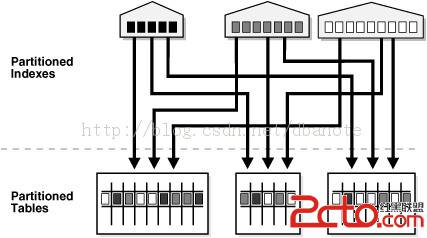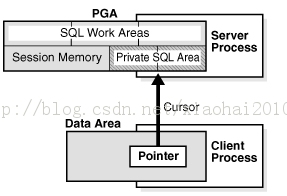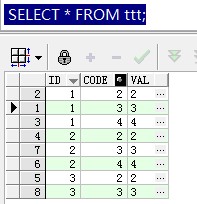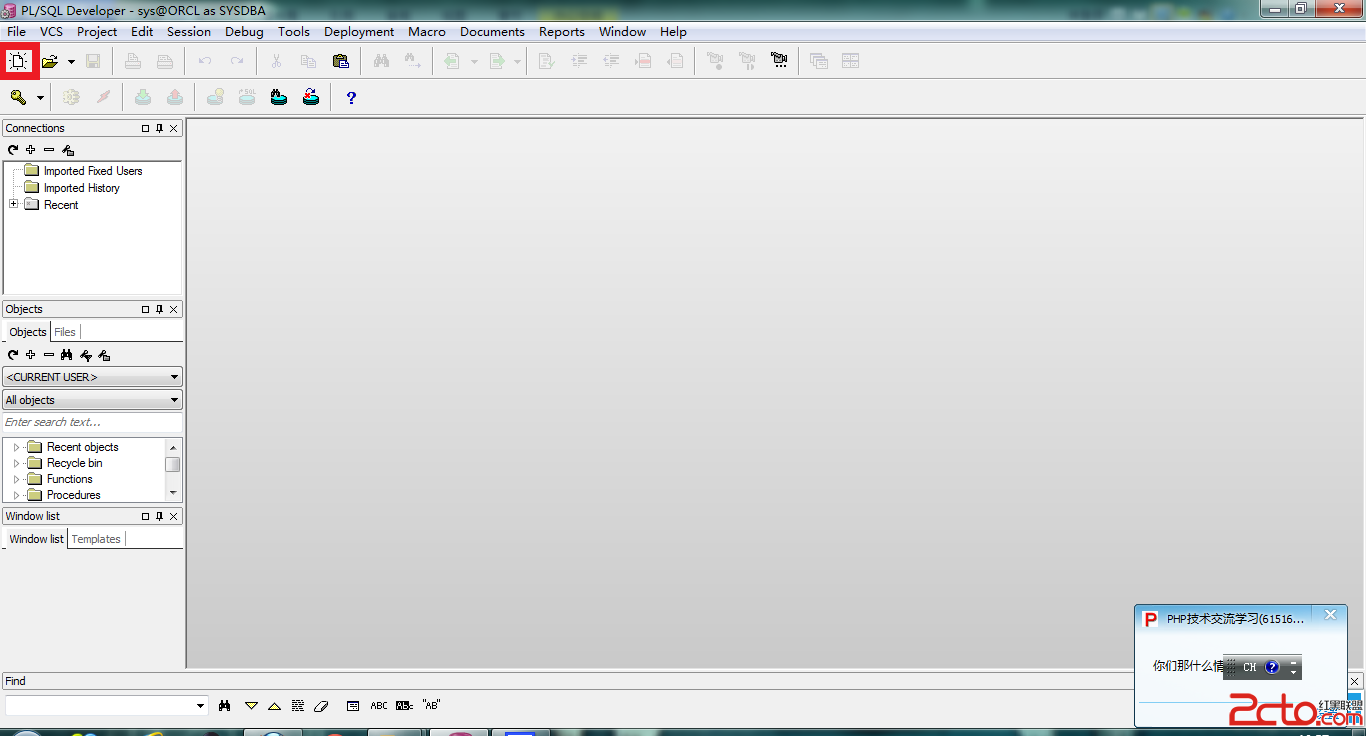Oracle主键、唯一键与唯一索引的区别
Oracle主键、唯一键与唯一索引的区别
一般,我们看到术语“索引”和“键”交换使用,但实际上这两个是不同的。索引是存储在数据库中的一个物理结构,键纯粹是一个逻辑概念。键代表创建来实施业务规则的完整性约束。索引和键的混淆通常是由于数据库使用索引来实施完整性约束。
接下来我们看看数据库中的主键约束、唯一键约束和唯一索引的区别。
SQL> select * from v$version; BANNER -------------------------------------------------------------------------------- Oracle Database 11g Enterprise Edition Release 11.2.0.1.0 - Production PL/SQL Release 11.2.0.1.0 - Production CORE 11.2.0.1.0 Production TNS for Linux: Version 11.2.0.1.0 - Production NLSRTL Version 11.2.0.1.0 - Production SQL> create table test ( 2 id int, 3 name varchar2(20), 4 constraint pk_test primary key(id)) 5 tablespace users; Table created. SQL> select constraint_name, constraint_type from user_constraints; CONSTRAINT_NAME C ------------------------------ - PK_TEST P
在test表中,我们指定了ID列作为主键,Oracle数据库会自动创建一个同名的唯一索引:
SQL> select index_name, index_type, uniqueness, tablespace_name 2 from user_indexes 3 where table_owner='SCOTT' 4 and table_name = 'TEST'; INDEX_NAME INDEX_TYPE UNIQUENES TABLESPACE_NAME -------------------- -------------------- --------- ------------------------------ PK_TEST NORMAL UNIQUE USERS
此时,如果我们再试图在ID列上创建一个唯一索引,Oracle会报错,因为该列上已经存在一个唯一索引:
SQL> create unique index idx_test_uk on test(id);
create unique index idx_test_uk on test(id)
*
ERROR at line 1:
ORA-01408: such column list already indexed
即使创建非唯一索引也不行:
SQL> create index idx_test_id on test(id);
create index idx_test_id on test(id)
*
ERROR at line 1:
ORA-01408: such column list already indexed
那么唯一键约束的情况是怎样的呢?
SQL> drop table test purge; Table dropped. SQL> create table test( 2 id int, 3 name varchar2(20), 4 constraint uk_test unique(id)); Table created. SQL> select constraint_name, constraint_type from user_constraints; CONSTRAINT_NAME C ------------------------------ - UK_TEST U
查看此时的索引情况:
SQL> select index_name, index_type, uniqueness, tablespace_name 2 from user_indexes 3 where table_owner='SCOTT' 4 and table_name = 'TEST'; INDEX_NAME INDEX_TYPE UNIQUENES TABLESPACE_NAME -------------------- -------------------- --------- ------------------------------ UK_TEST NORMAL UNIQUE USERS
Oracle同样自动创建了一个同名的唯一索引,而且也不允许再在此列上创建唯一索引或非唯一索引。
我们知道,主键约束要求列值非空(NOT NULL),那么唯一键约束是否也要求非空呢?
SQL> insert into test values(1, 'Sally');
1 row created.
SQL> insert into test values(null, 'Tony');
1 row created.
SQL> insert into test values(null, 'Jack');
1 row created.
SQL> select * from test;
ID NAME
---------- --------------------
1 Sally
Tony
Jack
从实验结果来看,唯一键约束并没有非空要求。
接下来我们看看唯一索引对列值的非空要求有什么不同。
SQL> drop table test purge;
Table dropped.
SQL> create table test(
2 id int,
3 name varchar2(20));
Table created.
SQL> create unique index idx_test_id on test (id);
Index created.
SQL> insert into test values(1, 'Sally');
1 row created.
SQL> insert into test values(null, 'Tony');
1 row created.
SQL> insert into test values(null, 'Jack');
1 row created.
SQL> select * from test;
ID NAME
---------- --------------------
1 Sally
Tony
Jack
通过实验,我们看出唯一索引与唯一键约束一样对列值非空不做要求。
如果我们让主键约束或者唯一键约束失效,Oracle自动创建的唯一索引是否会受到影响?
SQL> drop table test purge; Table dropped. SQL> create table test( 2 id int, 3 name varchar2(20), 4 constraint uk_test unique(id)); Table created. SQL> select index_name, index_type, uniqueness from user_indexes; INDEX_NAME INDEX_TYPE UNIQUENES ------------------------------ --------------------------- --------- UK_TEST NORMAL UNIQUE SQL> alter table test disable constraint uk_test; Table altered. SQL> select index_name, index_type, uniqueness from user_indexes; no rows selected SQL> alter table test disable constraint uk_test; Table altered. SQL> select index_name, index_type, uniqueness from user_indexes; INDEX_NAME INDEX_TYPE UNIQUENES ------------------------------ --------------------------- --------- UK_TEST NORMAL UNIQUE
当主键约束或者唯一键约束失效时,Oracle会标记隐式创建的唯一索引为删除状态。
=====================================================
Using Nonunique Indexes to Enforce Uniqueness
You can use an existing nonunique index on a table to enforce uniqueness, either for UNIQUE constraints or the unique aspect of a PRIMARY KEY constraint. The advantage of this approach is that the index remains available and valid when the constraint is disabled. Therefore, enabling a disabled UNIQUE or PRIMARY KEY constraint does not require rebuilding the unique index associated with the constraint. This can yield significant time savings on enable operations for large tables.
Using a nonunique index to enforce uniqueness also lets you eliminate redundant indexes. You do not need a unique index on a primary key column if that column is included as the prefix of a composite index. You can use the existing index to enable and enforce the constraint. You also save significant space by not duplicating the index. However, if the existing index is partitioned, then the partitioning key of the index must also be a subset of the UNIQUE key; otherwise, Oracle Database creates an additional unique index to enforce the constraint.
=====================================================
如果我们先创建唯一索引,再创建主键或者唯一键约束,情况又会怎样呢?
SQL> drop table test purge; Table dropped. SQL> create table test( 2 id int, 3 name varchar2(20)); Table created. SQL> create unique index idx_test_id on test (id); Index created. SQL> select index_name, index_type, uniqueness 2 from user_indexes 3 where table_owner = 'SCOTT' 4 and table_name = 'TEST'; INDEX_NAME INDEX_TYPE UNIQUENES ------------------------------ --------------------------- --------- IDX_TEST_ID NORMAL UNIQUE SQL> alter table test add constraint uk_test unique (id); Table altered. SQL> select in
- 更多Oracle疑问解答:
- 运行exp备份oracle数据库提示oracle-12154错误
- 有没有,生产Oracle Rman 备份脚本的工具啊!
- 初学orcle,希望有大大帮忙解说一下详细步骤,从登录oracle到创建表的过程
- oracle语句问题:一张user表,三个字段,id,name,time,插入记录比如:张三2007,李四2008,张三2011
- 如何写一个ORACLE触发器同步两个表中的数据?
- oracle 如何查看一个服务器上有多少个数据库.
- oracle 创建包的时候错误 求解
- oracle 重复列的问题
- oracle 中如何查处2星期前的数据
- 请教oracle数据库安装中的问题
- 请问谁能提供给我标准的oracle ERP的数据库表结构并详细说明各表主要的作用?
- 安装oracle遇到的问题 invalid entry CRC (expected 0x3e12e795 but got 0x9db0e9fd)
- 我的是ORACLE 10G,在RMAN中如何按指定的时间恢复数据文件啊?
- oracle为什么没有自动增长列
- oracle快捷键都有哪些啊?





